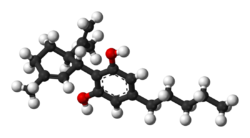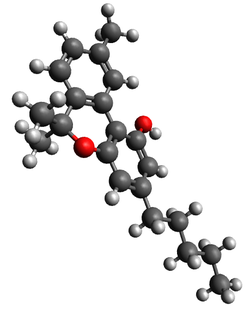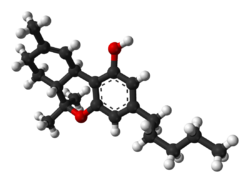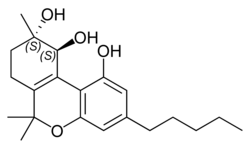Comparison of phytocannabinoids
Cannabinoids () are compounds found in the cannabis plant or synthetic compounds that can interact with the endocannabinoid system .[ 1] [ 2] tetrahydrocannabinol (THC) (Delta-9-THC), the primary intoxicating compound in cannabis .[ 3] [ 4] Cannabidiol (CBD) is another major constituent of some cannabis plants.[ 5] Conversion of CBD to THC can occur when CBD is heated to temperatures between 250–300 °C (480 to 570°F), potentially leading to its partial transformation into THC.[ 6]
At least 113 distinct cannabinoids have been isolated from cannabis.[ 7]
Structures
Legality
Cannabinoid
Quasi-psychedelic
Drug precursor
Legal status
CBCA , CBC
Legal in most countries
CBCVA , CBCV
CBDA , CBD
No
THC[ 6]
See Cannabidiol § Legal status
CBDD
CBDH
CBDO
CBDPA , CBDP
CBDVA , CBDV
CBEA , CBE
CBGA , CBG
CBGVA , CBGV
CBLA , CBL
CBNA , CBN
CBNDA , CBND
CBTA , CBT
CBVA , CBV
delta -3-THCYes
Legal in most countries
delta -4-THCYes
Legal in most countries
delta -7-THCYes
Legal in most countries
delta -8-THCYes
Legal in most countries
delta -10-THCYes
Legal in most countries
delta -11-THCYes
Legal in most countries
THCA , THC
Yes
UN Convention on Psychotropic Substances
THCB
THCCA , THCC
THCH
Yes
Legal in most countries
THCPA , THCP
Yes
Legal in most countries
THCVA , THCV
Thermal properties
Conversion temperatures
Cyclization reaction
Temperature
CBD → THC
250 °C (482 °F) to 300 °C (572 °F)[ 6]
Decarboxylation temperatures
All cannabinoids listed here and their acids are found naturally in the plant to varying degrees.
Upon heating, cannabinoid acids decarboxylate to give their psychoactive cannabinoid. For example, Delta-9-tetrahydrocannabinol (THC) is the main psychoactive compound found in cannabis and is responsible for the "high" feeling when consumed. However, cannabis does not naturally contain significant amounts of THC. Instead, tetrahydrocannabinolic acid (THCA) is found naturally in raw and live cannabis and is non-intoxicating. Over time, THCA slowly converts to THC through a process of decarboxylation over the course of roughly a year, but can be sped up with exposure to high temperatures. When heated under conditions of 110 °C, decarboxylation generally occurs in 30–45 minutes. The decarboxylated THCA (THC) is added to cannabis edibles , as THCA is not orally active. When consumed orally, the liver breaks down and metabolizes THC into the more potent 11-hydroxy-THC .
Vaporization temperatures
Dry-herb vaporizers can be used to inhale cannabis in its flower form. There are 483 identifiable chemical constituents known to exist in the cannabis plant, and at least 85 different cannabinoids have been isolated from the plant.[ 10] tetrahydrocannabinol (THC) , and other cannabinoids also found in cannabis (often legally sold as cannabinoid isolates) like cannabidiol (CBD) , cannabichromene (CBC) , cannabigerol (CBG) , cannabinol (CBN) , do not vaporize until near their respective boiling points .
The cannabinoids listed here are found in the plant but only in trace amounts. However, they have also been extracted and sold as isolates online. Third party certification may help ensure buyers to avoid synthetic cannabinoids .
Structural scheduling
Table of plant cannabinoids[ 13]
Cannabigerol-type (CBG)
Cannabigerol (E )-CBG-C5
Cannabigerol(E )-CBGM-C5 A
Cannabinerolic acid A(Z )-CBGA-C5 A
Cannabigerovarin(E )-CBGV-C3
Cannabigerolic acid A(E )-CBGA-C5 A
Cannabigerolic acid A(E )-CBGAM-C5 A
Cannabigerovarinic acid A(E )-CBGVA-C3 A
Cannabichromene-type (CBC)
(±)-Cannabichromene CBC-C5
(±)-Cannabichromenic acid ACBCA-C5 A
(±)-Cannabivarichromene, (±)-Cannabichromevarin CBCV-C3
(±)-CannabichromevarinicCBCVA-C3 A
Cannabidiol-type (CBD)
(−)-Cannabidiol CBD-C5
CannabidiolCBDM-C5
Cannabidiol-C4 CBD-C4
(−)-Cannabidivarin CBDV-C3
Cannabidiorcol CBD-C1
Cannabidiolic acid CBDA-C5
Cannabidivarinic acidCBDVA-C3
Cannabinodiol-type (CBND)
CannabinodiolCBND-C5
CannabinodivarinCBND-C3
Tetrahydrocannabinol-type (THC)
Δ9 -Tetrahydrocannabinol Δ9 -THC-C5
Δ9 -Tetrahydrocannabinol-C4 Δ9 -THC-C4
Δ9 -Tetrahydrocannabivarin Δ9 -THCV-C3
Δ9 -Tetrahydrocannabiorcol Δ9 -THCO-C1
Δ9 -Tetrahydro- Δ9 -THCA-C5 A
Δ9 -Tetrahydro-Δ9 -THCA-C5 B
Δ9 -Tetrahydro-4 Δ9 -THCA-C4 A and/or B
Δ9 -Tetrahydro-Δ9 -THCVA-C3 A
Δ9 -Tetrahydro-Δ9 -THCOA-C1 A and/or B
(−)-Δ8 -trans -(6aR ,10aR )-Δ8 -Tetrahydrocannabinol Δ8 -THC-C5
(−)-Δ8 -trans -(6aR ,10aR )-Δ8 -THCA-C5 A
(−)-(6aS ,10aR )-Δ9 -Tetrahydrocannabinol (−)-cis -Δ9 -THC-C5
Cannabinol-type (CBN)
Cannabinol CBN-C5
Cannabinol-C4 CBN-C4
Cannabivarin CBN-C3
Cannabinol-C2 CBN-C2
CannabiorcolCBN-C1
Cannabinolic acid ACBNA-C5 A
Cannabinol methyl etherCBNM-C5
Cannabitriol-type (CBT)
(−)-(9R ,10R )-trans -(−)-trans -CBT-C5
(+)-(9S ,10S )-Cannabitriol(+)-trans -CBT-C5
(±)-(9R ,10S /9S ,10R )-(±)-cis -CBT-C5
(−)-(9R ,10R )-trans -(−)-trans -CBT-OEt-C5
(±)-(9R ,10R /9S ,10S )-3 (±)-trans -CBT-C3
8,9-Dihydroxy-Δ6a(10a) -8,9-Di-OH-CBT-C5
Cannabidiolic acid ACBDA-C5 9-OH-CBT-C5 ester
(−)-(6aR ,9S ,10S ,10aR )-Cannabiripsol-C5
(−)-6a,7,10a-Trihydroxy-9 -tetrahydrocannabinol(−)-Cannabitetrol
10-Oxo-Δ6a(10a) -OTHC
Cannabielsoin-type (CBE)
(5aS ,6S ,9R ,9aR )-Cannabielsoin CBE-C5
(5aS ,6S ,9R ,9aR )-3 -CannabielsoinCBE-C3
(5aS ,6S ,9R ,9aR )-CBEA-C5 A
(5aS ,6S ,9R ,9aR )-CBEA-C5 B
(5aS ,6S ,9R ,9aR )-3 -Cannabielsoic acid BCBEA-C3 B
Cannabiglendol-C3 OH-iso-HHCV-C3
DehydrocannabifuranDCBF-C5
CannabifuranCBF-C5
Isocannabinoids
(−)-Δ7 -trans -(1R ,3R ,6R )-
(±)-Δ7 -1,2-cis -R ,3R ,6S /1S ,3S ,6R )-
(−)-Δ7 -trans -(1R ,3R ,6R )-
Cannabicyclol-type (CBL)
(±)-(1aS ,3aR ,8bR ,8cR )-Cannabicyclol CBL-C5
(±)-(1aS ,3aR ,8bR ,8cR )-CBLA-C5 A
(±)-(1aS ,3aR ,8bR ,8cR )-CBLV-C3
Cannabicitran-type (CBT)
CannabicitranCBT-C5
Cannabichromanone-type (CBCN)
CannabichromanoneCBCN-C5
Cannabichromanone-C3 CBCN-C3
CannabicoumarononeCBCON-C5
References
^ Abyadeh M, Gupta V, Paulo JA, Gupta V, Chitranshi N, Godinez A, et al. (September 2021). "A Proteomic View of Cellular and Molecular Effects of Cannabis" . Biomolecules . 11 (10): 1411– 1428. doi :10.3390/biom11101411 PMC 8533448 PMID 34680044 . ^ "Marijuana, also called: Cannabis, Ganja, Grass, Hash, Pot, Weed" . Medline Plus . 3 July 2017.^ Lambert DM, Fowler CJ (August 2005). "The endocannabinoid system: drug targets, lead compounds, and potential therapeutic applications". Journal of Medicinal Chemistry . 48 (16): 5059– 5087. doi :10.1021/jm058183t . PMID 16078824 . ^ Pertwee R, ed. (2005). Cannabinoids 2 . ISBN 978-3-540-22565-2 ^ "Bulletin on Narcotics – 1962 Issue 3 – 004" . UNODC (United Nations Office of Drugs and Crime). 1962-01-01. Retrieved 2014-01-15 .^ a b c Czégény Z, Nagy G, Babinszki B, Bajtel Á, Sebestyén Z, Kiss T, et al. (April 2021). "CBD, a precursor of THC in e-cigarettes" . Scientific Reports . 11 (1): 8951. Bibcode :2021NatSR..11.8951C . doi :10.1038/s41598-021-88389-z . PMC 8076212 PMID 33903673 . ^ Aizpurua-Olaizola O, Soydaner U, Öztürk E, Schibano D, Simsir Y, Navarro P, et al. (February 2016). "Evolution of the Cannabinoid and Terpene Content during the Growth of Cannabis sativa Plants from Different Chemotypes". Journal of Natural Products . 79 (2): 324– 331. doi :10.1021/acs.jnatprod.5b00949 . PMID 26836472 . ^ Wang M, Wang YH, Avula B, Radwan MM, Wanas AS, van Antwerp J, et al. (1 December 2016). "Decarboxylation Study of Acidic Cannabinoids: A Novel Approach Using Ultra-High-Performance Supercritical Fluid Chromatography/Photodiode Array-Mass Spectrometry" . Cannabis and Cannabinoid Research . 1 (1): 262– 271. doi :10.1089/can.2016.0020 . PMC 5549281 PMID 28861498 . ^ Wang M, Wang YH, Avula B, Radwan MM, Wanas AS, van Antwerp J, et al. (2016). "Decarboxylation Study of Acidic Cannabinoids: A Novel Approach Using Ultra-High-Performance Supercritical Fluid Chromatography/Photodiode Array-Mass Spectrometry" . Cannabis and Cannabinoid Research . 1 (1): 262– 271. doi :10.1089/can.2016.0020 . PMC 5549281 PMID 28861498 . ^ El-Alfy AT, Ivey K, Robinson K, Ahmed S, Radwan M, Slade D, et al. (June 2010). "Antidepressant-like effect of delta9-tetrahydrocannabinol and other cannabinoids isolated from Cannabis sativa L" . Pharmacology, Biochemistry, and Behavior . 95 (4): 434– 442. doi :10.1016/j.pbb.2010.03.004 . PMC 2866040 PMID 20332000 . ^ a b c d e f "Phytocannabinoid Boiling Points" (PDF) . projectcbd.org . Archived (PDF) from the original on 2019-04-08. Retrieved 20 August 2021 .^ "CompTox Chemicals Dashboard" . comptox.epa.gov . Retrieved 10 April 2024 .[dead link ^ "Table of Natural Cannabinoids" (PDF) .
Phytocannabinoids comparison )
Cannabibutols Cannabichromenes Cannabicyclols Cannabidiols Cannabielsoins Cannabigerols Cannabiphorols Cannabinols Cannabitriols Cannabivarins Delta-3-tetrahydrocannabinols Delta-4-tetrahydrocannabinols Delta-7-tetrahydrocannabinols Delta-8-tetrahydrocannabinols Delta-9-tetrahydrocannabinols Delta-10-Tetrahydrocannabinols Delta-11-Tetrahydrocannabinols Miscellaneous cannabinoids Active metabolites
Endocannabinoids Synthetic
Classical cannabinoids Non-classical Adamantoylindoles Benzimidazoles Benzoylindoles Cyclohexylphenols Eicosanoids Indazole-3- Indole-3-carboxamides Indole-3-carboxylates Naphthoylindazoles Naphthoylindoles Naphthoylpyrroles Naphthylmethylindenes Naphthylmethylindoles Phenylacetylindoles Pyrazolecarboxamides Tetramethylcyclo- Tetramethylcyclo- Others
Allosteric CBR Tooltip Cannabinoid receptor ligands Endocannabinoid (inactivation inhibitors) Anticannabinoids (antagonists/inverse






























































































































